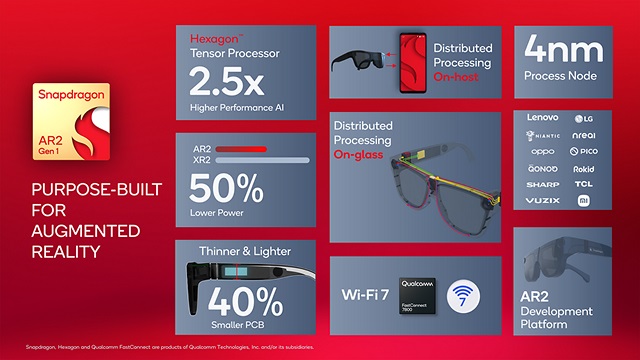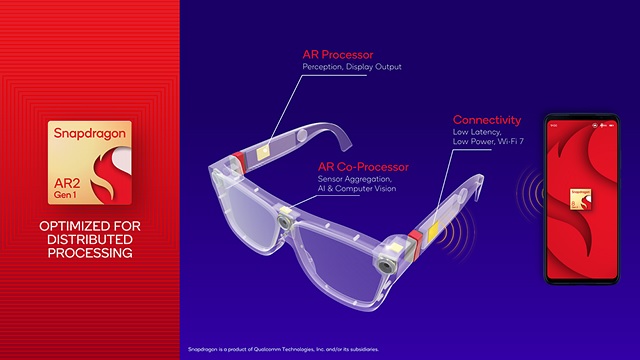In Augmented Reality News
November 17, 2022 – Qualcomm Technologies, Inc., a global provider of semiconductors and a key enabler of the metaverse through its continued investments and research in extended reality (XR) technology, has this week announced at its Snapdragon Summit 2022 the ‘Snapdragon AR2 Gen 1 Platform.’ The device has been designed to deliver “groundbreaking” augmented reality (AR) technology that the company hopes will unlock a new generation of sleek, highly capable glasses.
Qualcomm added that the Snapdragon AR2 has been built from the ground up to “revolutionize the headworn glass form factor and usher in a new era of spatial computing experiences for the real-world/metaverse mix.”
The platform is built around a multi-chip distributed processing architecture combined with customized IP blocks in order to create the thinnest possible AR glass, according to Qualcomm. Compared to the company’s Wireless AR Smart Viewer Reference Design (powered by the Snapdragon XR2 Platform), the AR2’s main processor occupies a 40% smaller PCB area on glass, and the overall platform delivers 2.5x better AI performance while consuming 50% less power, which helps to achieve AR glasses that consume <1W power.
This should enable rich AR experiences on glasses that can be comfortably worn for extended periods of time and meet the demands of both consumers and enterprise use cases.

Snapdragon AR2’s Distributed Processing Architecture
In order to better balance the weight and decrease the arm width on either side of the glasses, Qualcomm has utilized a multi-chip architecture for the Snapdragon AR2 that includes an AR processor, AR co-processor and connectivity platform.
Snapdragon AR2 dynamically distributes the processing of latency-sensitive perception data directly on the glasses and offloads more complex data processing requirements to a Snapdragon-powered smartphone, PC or to other compatible host devices. Working in tandem, this processing architecture works since:
- The AR processor is optimized for low motion-to-photon latency while supporting up to nine (9) concurrent cameras for user and environmental understanding. Its enhanced perception capabilities include a dedicated hardware acceleration engine that improves user motion tracking and localization, an AI accelerator to reduce latency for sensitive input interactions such as hand tracking or 6DoF, and a reprojection engine for a smoother experience;
- The AR co-processor aggregates camera and sensor data and enables eye tracking and iris authentication for foveated rendering, to optimize workloads only where the user is looking. This helps reduce power consumption;
- The connectivity platform utilizes the Qualcomm FastConnect 7800 connectivity system to unlock Wi-Fi 7 technology and reaches <2ms latency between the AR glasses and the smartphone or host device, according to Qualcomm. Plus, embedded support for the FastConnect XR Software Suite 2.0 enables better control of XR data to improve latency, reduce jitter and avoid unwanted interference.

Qualcomm’s AR Ecosystem
Beyond the Snapdragon AR2 technology, Qualcomm stated that it is critical to deliver an end-to-end solution that consists of hardware, a suite of perception technologies, and the software tools to build immersive experiences. Therefore, in order to allow developers to build incredible headworn AR applications, Snapdragon AR2 and the Snapdragon 8 Gen 2 Platform are optimized to be Snapdragon Spaces ready.
“We built Snapdragon AR2 to address the unique challenges of headworn AR and provide industry-leading processing, AI and connectivity that can fit inside a stylish form factor,” said Hugo Swart, vice president of XR product management, Qualcomm Technologies, Inc. “With the technical and physical requirements for VR/MR and AR diverging, Snapdragon AR2 represents another metaverse-defining platform in our XR portfolio to help our OEM partners revolutionize AR glasses.”
“Microsoft worked closely with Qualcomm on the platform requirements for Snapdragon AR2 to help define the purpose-built, foundational technologies to unlock new possibilities in AR experiences,” said Rubén Caballero, Corporate Vice President of Mixed Reality, Devices & Technology, Microsoft. “Snapdragon AR2 platform innovations will revolutionize headworn AR devices that will transform immersive productivity and collaboration and we look forward to seeing the innovation that Qualcomm and its partners will bring to market.”
For more information, on Qualcomm and its newly announced Snapdragon AR2 platform, please visit the company’s website.
Image / video credit: Qualcomm
About the author
Sam is the Founder and Managing Editor of Auganix. With a background in research and report writing, he has been covering XR industry news for the past seven years.
